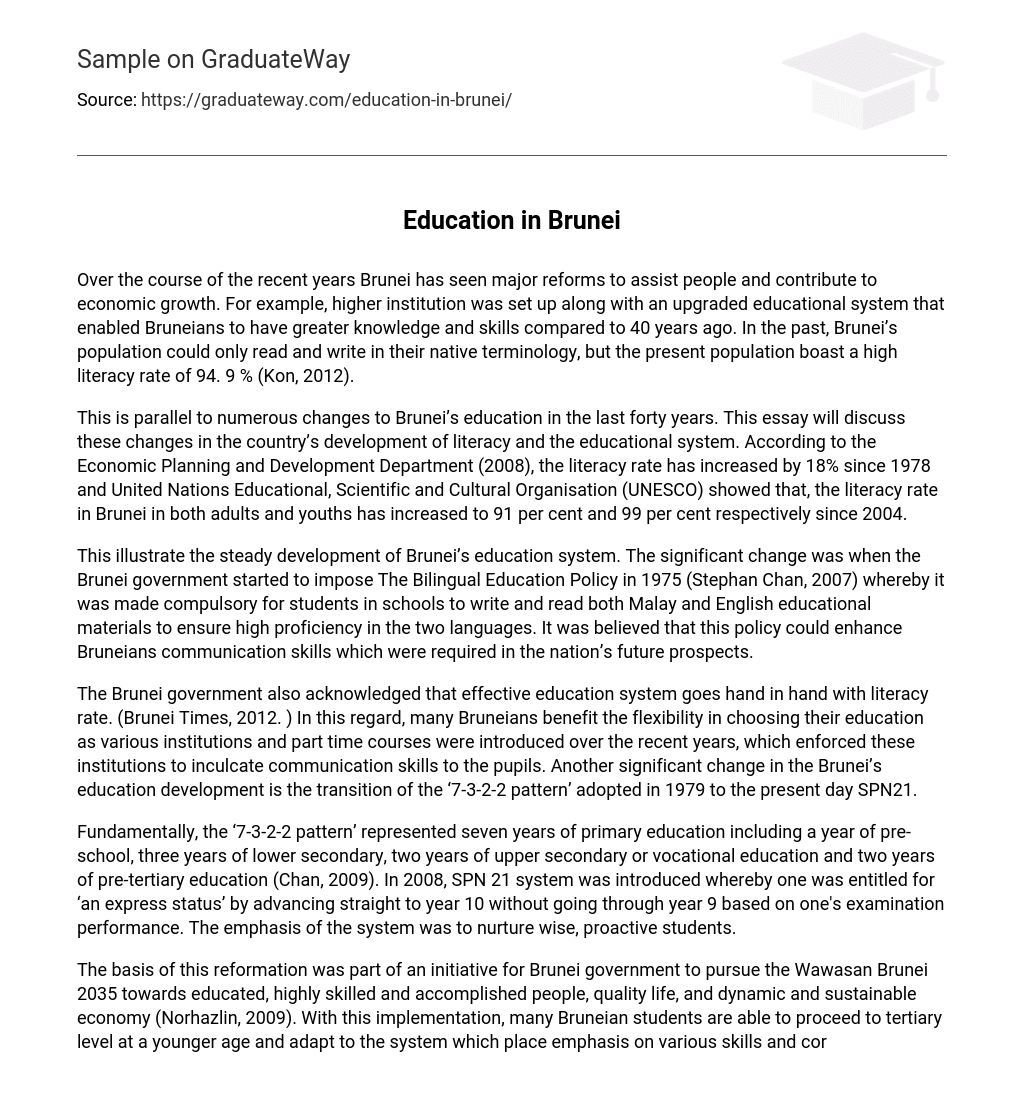Over the past few years, Brunei has implemented significant changes to promote its citizens and boost economic development. These changes involve setting up advanced educational institutions, improving the education system, and consequently equipping Bruneians with more knowledge and skills than they had four decades ago. In the past, Brunei’s population was limited to reading and writing in their native language. However, today, the literacy rate stands at an impressive 94.9% (Kon, 2012).
According to reports from the Economic Planning and Development Department (2008) and UNESCO, the essay will examine Brunei’s literacy development and educational system over the last four decades. These reports reveal that Brunei has experienced a notable growth in its literacy rate since 1978, with an increase of 18%. By 2004, the adult literacy rate had reached 91% and the youth literacy rate had reached an impressive 99%.
This demonstrates the continuous progress of Brunei’s education system, specifically the milestone achieved in 1975 with the implementation of the Bilingual Education Policy (Stephan Chan, 2007). Under this policy, Bruneian students were required to learn and comprehend educational materials in both Malay and English languages. The objective was to develop proficiency in both languages and improve communication abilities among Bruneians, recognizing their importance for future national endeavors.
According to the Brunei Times (2012), the Brunei government recognizes the importance of a strong education system in promoting literacy. It has introduced various institutions and part-time courses to offer more options for education. These changes have also led to a focus on developing communication skills among students. Additionally, there has been a shift from the previous ‘7-3-2-2 pattern’ of education to the current SPN21 system.
Fundamentally, the ‘7-3-2-2 pattern’ represented seven years of primary education including a year of pre-school, three years of lower secondary, two years of upper secondary or vocational education and two years of pre-tertiary education (Chan, 2009). In 2008, the SPN 21 system was introduced, which allowed students to advance straight to year 10 without going through year 9 based on their examination performance. The main focus of this system was to cultivate intelligent and proactive students.
The Brunei government’s initiative to pursue the Wawasan Brunei 2035, which aims for educated, highly skilled and accomplished people, quality life, and a dynamic and sustainable economy (Norhazlin, 2009), formed the basis for this reformation. As a result, numerous Bruneian students are now able to progress to tertiary level at a younger age and adjust to a system that emphasizes different skills and core values instead of purely knowledge.
The Bilingual policy in Brunei has significantly contributed to the high literacy rate in the country. Recognizing the importance of fluency in the national language and English, which is widely spoken globally, has played a crucial role. Additionally, the establishment of institutions in Brunei has been vital in promoting literacy development from the grassroots level. However, feedback on the SPN education system has been varied.
While the SPN system received praise, there are also concerns about replacing exams with continuous projects and homework. Critics worry that teachers will find it challenging to assess a student’s ability to cope with and understand a subject. For instance, the accelerated syllabus in year 10 may cause stress and depression for students who can’t handle it, impacting their future prospects.
In recent years, there has been a positive progression in the evolution of education in Brunei Darussalam. The country recognized the importance of equipping its population with 21st Century skills to address social and economic challenges. This progress has been achieved through policy introductions, system reforms, and providing proper education. As a result, Brunei Darussalam has made steady progress in empowering its population with good literacy skills and well-rounded individuals.
Bibliography:
•Kon, J. (2012). Brunei’s literacy rate among world’s highest. Retrieved October 21st 2012 from http://www.brudirect.com/index.php/Local-News/bruneis-literacy-rate-among-worlds-highest.html
•Brunei Literacy Rate Set For Big Increase. (2008, September 10). The Brunei Times, p. 22
•Chan, S. (2009). The Evolution Of Education in Brunei Darussalam. Retrieved October 18, 2012 from





